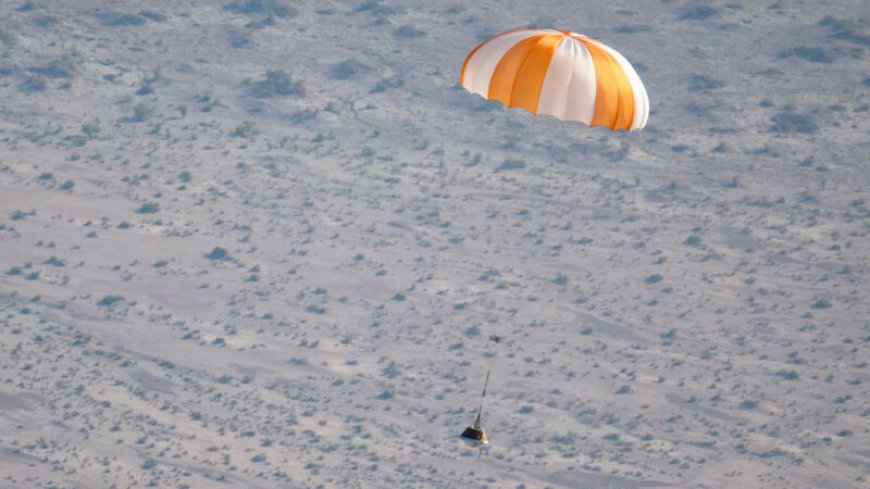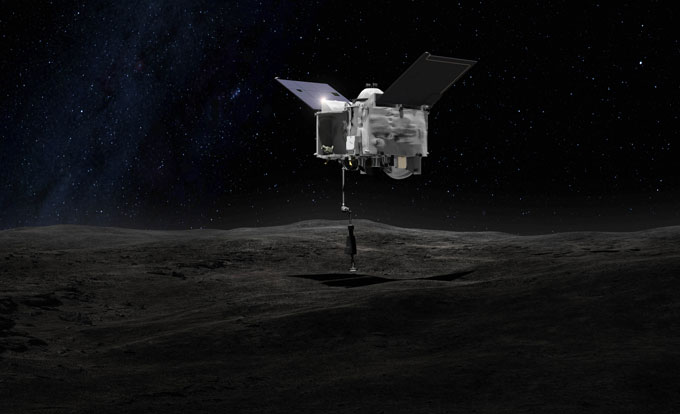NASA’s OSIRIS-REx is poised to return bits of the asteroid Bennu to Earth
Asteroid dirt from Bennu could help reveal clues about the material that came together to make the solar system — and possibly where life comes from.

Seven years is a long time to wait for your carrier service to deliver a package. That’s how long it’s been since NASA’s OSIRIS-REx spacecraft set off to gather rocks and dust from the asteroid Bennu. But the package is now nearly out for delivery.
On September 24, the spacecraft will fly near Earth and drop off a capsule containing material collected from Bennu in October 2020 — if all goes well (SN: 10/21/20).
This is the third mission to retrieve bits of an asteroid, and the first for NASA and the United States. The amount of asteroid material onboard this time far exceeds the micrograms that Japan’s Hayabusa spacecraft returned in 2005, from the asteroid Itokawa, and the five grams that Hayabusa2 collected in 2018 from Ryugu (SN: 6/14/10; SN: 12/7/20).
The Bennu sample is scheduled to arrive with a timing and precision that would make most terrestrial delivery services jealous. After a three-year journey back from the asteroid, the capsule should enter the atmosphere at 10:42 a.m. EDT, NASA says. Following an initially scorching descent, the capsule will release a parachute and descend to its destination at Hill Air Force Base near Ogden, Utah.
Live coverage of the event will be available on NASA’s website starting at 10 a.m. EDT.
If the asteroid bits survive the descent, they could help reveal what sort of materials came together to build our solar system. Getting a good look at the stuff that Bennu is made of could also provide insights into the risks that nearby asteroids pose to us, in the event that they are on a collision course with Earth. The asteroid cargo may even hold clues to help answer one of the biggest questions in science — how did life begin?
“I’m really focused on … trying to understand if these kinds of carbon-rich asteroids may have delivered the seeds of life,” says planetary scientist Dante Lauretta of the University of Arizona in Tucson, who leads the OSIRIS-REx mission. “So we’re looking for things like amino acids, which are in our proteins, and nucleic acids,” the building blocks of the genetic instructions that make life possible on Earth.
Lauretta says there’s essentially no chance of finding anything alive on asteroids like Bennu. But in the collected rocks and dust, “we could really see how organic molecular chemistry can evolve before life shows up.”

At about 250 grams, the asteroid sample in the OSIRIS-REx return capsule is just a bit heavier than a cup of coffee. But it is a huge cache of asteroid material, as far as mission scientists are concerned. The sample size far exceeds the quantity initially hoped for, Lauretta says.
“We came up with 15 grams” as a reasonable sample size to analyze, he says, “which is an enormous amount of material in analytical chemistry these days.” But NASA allows Lauretta and his team to keep only a quarter of the sample for their own use. Some of the remaining portion will be distributed to scientists around the globe, with the rest reserved for future studies.
That meant collecting 60 grams from Bennu would have been enough to ensure that Lauretta and his colleagues had their hoped-for sample. “The fact that we got over four times that is just phenomenally successful,” Lauretta says.
Recipe for an asteroid
Researchers are already envisioning all they can learn from Bennu.
Physicist Mikael Granvik of the University of Helsinki hopes analyses of the Bennu material will help reveal the potential for mining asteroids for water and raw materials that could supply future space missions.
The asteroid bits could also aid his investigations of how fragile some space rocks might be. “What happens to asteroids of the same type as Bennu when they get closer to the sun?” says Granvik, who is not a member of the OSIRIS-REx team. He and his colleagues propose that the interaction with the sun causes such “rubble pile asteroids,” made of loosely bound material, to break apart. The hypothesis could explain why there are fewer rubble pile asteroids in orbits near the sun than expected.
To test the idea, Granvik exposes samples to harsh conditions that approximate what it would be like near the sun, basically destroying the material. For that reason, he doesn’t expect to use any of the precious Bennu rock. Instead, Granvik hopes to learn the Bennu asteroid recipe and then order up asteroid analogs from suppliers who will blend together materials mimicking the Bennu mix. It’s an example of how the returned sample could expand research opportunities even for scientists who don’t get a share of the real thing.
Stories Bennu can tell
For planetary scientist Jessica Sunshine of the University of Maryland in College Park, much of the value in sample return missions is in stories asteroids can tell us about the formation of the Earth and solar system. “We think of them as sort of dead rocks, and they’re not. I mean, they have undergone significant evolution, both chemical and physical in the 4.5 billion years since they formed,” Sunshine says.
Like Lauretta, Sunshine hopes to learn how those processes ultimately led to the origins of life, but studying near-Earth asteroids is crucial for understanding the threats asteroids pose as well. “In principle, they could have given us life and they could take it away,” Sunshine says, “I mean, from the dinosaur’s perspective, they did take it away.”
Sunshine is member of the team that sent the DART spacecraft to nudge asteroid Dimorphos into a new orbit to see if it was possible to push asteroids off courses that threaten Earth (SN: 10/11/22). “If you’re worried about the asteroid hazard problem, we pretty much better understand what is the physical and compositional variability of all these things that might hit us,” Sunshine says. “Because depending on what they’re made of and how they’re made, it’s going to change their effect when they hit us. If they ever hit us.”
There may be more than bits of just Bennu in the return capsule, says astronomer Humberto Campins of the University of Central Florida in Orlando, who is a member of the OSIRIS-REx team. Some highly reflective boulders on Bennu don’t match the rest of the asteroid, which is very dark. The most likely reason, Campins says, is that the bright chunks come from collisions with other asteroids.
“There’s no guarantee, but I’m hoping that in our sample there will be some fraction, some pieces, grains that come from those other asteroids,” Campins say. Remote analyses suggest that some of the bright pieces on Bennu are a good match for the asteroid Vesta. “So we would have a sample return not just from Bennu, but from possibly from Vesta,” Campins says, “or who knows what other asteroid.”
Though this will be NASA’s first sample return of an asteroid, the Stardust mission in 2006 successfully returned samples of comet Wild-2, also to Utah (SN: 8/14/14).
Next stop: Asteroid Apophis
OSIRIS-REx’s mission won’t end with the package delivery in Utah. “After we drop the capsule off,” Lauretta says, “the spacecraft is still healthy. It’s going to fire a deflection maneuver, and [then] it’s on a route to another asteroid — Asteroid Apophis,” which is about as far away from Earth as Bennu is.
At that point, the satellite will get a new name, OSIRIS-APEX, and will be set to orbit Apophis once it arrives in April of 2029, if everything goes to plan. But it won’t be bringing any more samples back to Earth. Unlike your local delivery trucks, OSIRIS-REx was designed to carry only one package and make a single delivery. After Sunday, the spacecraft’s delivery days are done.
What's Your Reaction?



























































